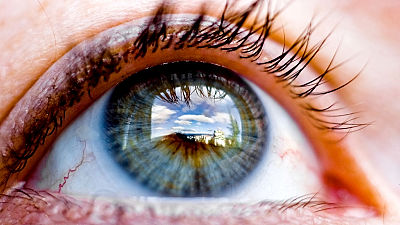How do people with aphantasia, who cannot visualize images in their heads, see the world?

Most people can picture a dog in their head when they hear the word 'dog,' but some people have
'A blind and deaf mind': what it's like to have no visual imagination or inner voice
https://theconversation.com/a-blind-and-deaf-mind-what-its-like-to-have-no-visual-imagination-or-inner-voice-226134
What is aphantasia anyway?
Below are images that Derek Arnold, a professor of psychology at the University of Queensland, and his doctoral student Lauren N. Breuer use to explain aphantasia. To people without aphantasia, the image on the left looks like a cube, and the image of a mop on the right looks like a human face, but to Breuer, who has aphantasia, the image on the left looks like a collection of lines, and the image on the right looks like nothing more than a mop.

Breuer is unable to visualize the scene or hear an inner voice reading the book aloud while reading. In
Both Arnold and Breyer are aphantasias, and are often asked by non-aphantasias, 'What does it feel like?' They explain the sensibility of aphantasia, which is often called 'mind blind' or 'mind deaf' because of the inability to reproduce images and voices in one's head:
◆The inner voice is multilingual
Aphantasia can range in severity, with some people unable to imagine any sensations at all, while others can only imagine some sensations. For example, while both Arnold and Breuer were unable to imagine sight, Arnold could imagine auditory sensations, and Breuer could imagine tactile sensations.
Arnold et al. describe this difference between being able to understand thought experiences and not being able to do so as 'like hearing a voice in an unknown language.'

Many people can hear their inner voice when they think, but for example, if you can only speak one language, the inner voice will always be in your native language. On the other hand, there are people in the world who speak many different languages, but if you hear a voice in a language you have not mastered, you will not be able to understand it.
'How would you feel if you heard your inner voice speaking several different languages? Similarly, thoughts may be diverse and experienced by some as sight or sound, and by others as touch or smell,' Arnold and colleagues explained.
Subconscious thinking
While most people can hear their speech in their head before speaking out loud, they can also just burst into speech without doing so. Breuer can't visualize his voice, but just as non-aphantasia can speak without listening to an inner voice, Breuer can write sentences without thinking about their content in advance.
In this way, the human brain processes many of its thoughts unconsciously. Breuer said, 'It's not exactly a great feeling, but I'm sure many of us have had the experience of driving a car in a distracted state and not realizing it until we're home or at the office. I also believe that most of my thoughts are similar to the workings of the subconscious mind.'
Breuer says that instead of being able to visualize his sight and sound, he plans things out as imaginary textures: for example, when he plans a speech, he imagines it as a series of mouth movements, body movements, and gestures.

In contrast to Breuer, Arnold's thinking is entirely linguistic, and he recalls, 'Until recently, I didn't even know that it was possible to think in ways other than words.'
These differences highlight the diversity of aphantasia, and Arnold et al. said, 'All we can do is speak to each of our individual experiences of aphantasia.'
The lack of shared perception can lead to frustration, but it can also lead to unexpected humor. While discussing an experiment with three other people, Arnold and Breyer decided to cut out the sentence, 'Imagine seeing a black cat with your eyes closed.'
Because neither of them could imagine a visual image, they thought they couldn't close their eyes and imagine a black cat. However, the only person who didn't have aphantasia burst out laughing after hearing their conversation. It was only then that the two realized that it was easy for people who didn't have aphantasia to close their eyes and imagine a black cat.

Deep Aphantasia
Neuroscientists believe that aphantasia occurs when activity in the front of the brain is unable to stimulate activity in the back, meaning that sensory imagery requires feedback from the front to the back of the brain.
Breyer's inability to form visual images and his experience of actual visual input, such as the image of the cube and mop, were so different from other people that Arnold and his colleagues coined the term 'deep aphantasia' to describe his condition.
Arnold and his colleagues discuss aphantasia in order to raise awareness that some people with aphantasia may see things differently than the average person. They also hope that by letting more people know that there are people who think in different ways, they will become more tolerant of different ideas.
Related Posts:
in Science, Posted by log1l_ks







